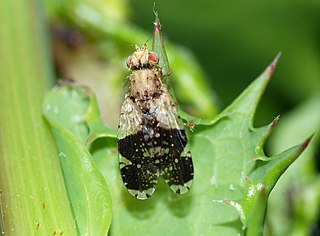
Canacidae, incorrectly Canaceidae, or beach flies, surf or surge flies, is a family of Diptera. As of 2010, 307 species in 27 genera. The family now includes Tethininae as a subfamily.

The Pyrgotidae are an unusual family of flies (Diptera), one of only two families of Cyclorrhapha that lack ocelli. Most species are "picture-winged", as is typical among the Tephritoidea, but unlike other tephritoids, they are endoparasitoids; the females pursue scarab beetles in flight, laying an egg on the beetle's back under the elytra where the beetle cannot reach it. The egg hatches and the fly larva enters the body cavity of the beetle, feeding and eventually killing the host before pupating. In the United States, some species of Pyrgota and Sphecomyiella can be quite common in areas where their host beetles are abundant. Like their host beetles, these flies are primarily nocturnal, and are often attracted to artificial lights.

Tephritis is a genus of flies. It contains around 170 described species, making it the sixth largest genus in the family Tephritidae. Many more undescribed species are known from specimen collections. Tephritis occur throughout much of the world, but most are Palearctic. They can be found in a wide range of climate types, from hot semidesert to tundra. Most species inhabit the inflorescences of plants from several tribes in the family Asteraceae, and a few species cause galls to form.

Urophora is a genus of tephritid or fruit flies in the family Tephritidae.
Rhochmopterum is a genus of tephritid or fruit flies in the family Tephritidae.

Trupanea is a genus of tephritid or fruit flies in the family Tephritidae.
Canacinae is a subfamily of beach flies in the family of Canacidae.
Dynomiellini, is a tribe of beach flies in the family of Canacidae.
Trichocanace is a genus of beach flies, insects in the family Canacidae. All known species are Australasian, Indomalayan, or Afrotropical.
Xanthocanace is a genus of beach flies in the family Canacidae. All known species are Oriental, Palearctic, or Afrotropical.

Canace nascia is a European species of Canacidae.
Procanace is a genus of beach flies. All known species are Oriental, Afrotropical, Palaearctic, Neotropical or Australasian.

Apetaenus is a genus of beach flies in the family Canacidae. They are endemic to the subantarctic archipelagos in association with colonies of penguins and other seabirds. Some species have vestigial wings.
Horaismopterinae is a subfamily of beach flies in the family of Canacidae. There are 5 species in 2 genera, all inhabiting oceanic seashores.
Tethinosoma is a genus of beach flies in the family Canacidae. The only known species, T. fulvifrons, is from New Zealand.

Tethininae, formally the family Tethinidae is a paraphyletic group of tiny drab-coloured or grey Acalyptratae flies. There are over 115 species in 7 genera known from all zoogeographic regions. They are inconspicuous flies which are still poorly known in some remote, huge, tropical areas.
Dasyrhicnoessa is a genus of beach flies in the family Canacidae. All known species are Afrotropical, Neotropical, Indomalayan, or Australasian-Oceanian in distribution.
Pseudorhicnoessa is a genus of beach flies, insects in the family Canacidae. All species are Indopacific in distribution.
Sigaloethina is a genus of beach flies, insects in the family Canacidae. All known species are Australasian in distribution.

Tethina is a genus of beach flies in the family Canacidae. They are found in all terrestrial biogeographic realms.







